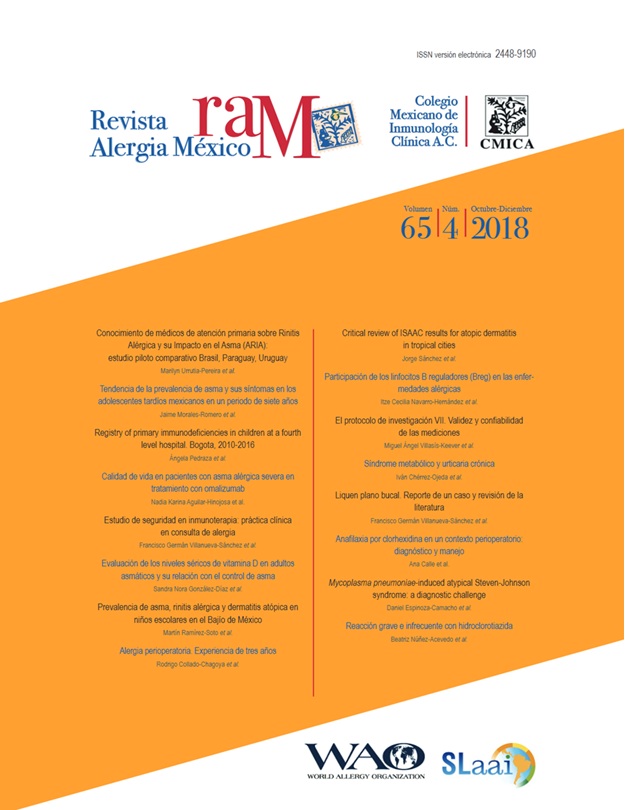Abstract
Background: During surgery, the patient is exposed to multiple medications and molecules that can be associated with the development hypersensitivity, which makes it difficult to detect the causative agent of a perioperative reaction and makes it necessary to perform allergy tests.
Case report: 53-year-old man who after a right knee arthroscopy was administered intravenous ketorolac; at 12 minutes, a pruriginous rash appeared on the chest, abdomen and limbs; infusion of the drug was immediately stopped and 100 mg intravenous hydrocortisone were administered. At 15 minutes, the patient experienced bilateral angioedema of the eyelids and a sensation of breathlessness, and oxygen was therefore administered, as well as 2 mg intravenous clemastine, 5 mg intravenous ranitidine and 20 µg subcutaneous adrenaline. Epidermal tests with 0.5 % chlorhexidine and serum chlorhexidine-specific immunoglobulin E (IgE) were performed, both with positive results. The patient recovered without complications; at discharge, he was prescribed intramuscular etofenamate.
Conclusion: Perioperative anaphylaxis is a rare, but potentially fatal event. Proper identification of the drug or substance responsible for the reaction by using allergy tests decreases unnecessary pharmacological restrictions and avoids re-exposure.
References
Odedra KM, Farooque S. Chlorhexidine: an unrecognised cause of anaphylaxis. Postgrad Med J. 2014;90(1070):709-714. DOI: 10.1136/postgradmedj-2013-132291.
Calogiuri GF, Trautmann A, Nettis E, Ferrannini A, Vacca A. Chlorhexidine hypersensitivity: a critical and updated review. J Allergy Ther. 2013;4(4):1-7. Disponible en: https://www.omicsonline.org/chlorhexidine-hypersensitivity-a-critical-and-updated-review-2155-6121.1000141.php?aid=15433
Mertes PM, Volcheck GW, Garvey LH, Takazawa T, Platt PR, Guttormsen AB, et al. Epidemiology of perioperative anaphylaxis. Presse Medicale. 2016;45(9):758-767. DOI: 10.1016/j.lpm.2016.02.024
Dhami S, Sheikh A. Anaphylaxis: epidemiology, aetiology and relevance for the clinic. Expert Rev Clin Immunol. 2017;13(9):889-895. DOI: 10.1080/1744666X.2017.1334552
Volcheck GW, Mertes PM. Local and general anesthetics immediate hypersensitivity reactions. Immunology Allergy Clin North Am. 2014;34(3):525-546. DOI: 10.1016/j.iac.2014.03.004
Michalska-Krzanowska G. Anaphylactic reactions during anaesthesia and the perioperative period. Anaesthesiol Intensive Ther. 2012;44(2):104-111. Disponible en: https://journals.viamedica.pl/anaesthesiology_intensivetherapy/article/view/19363/15432
Mertes PM, Malinovsky JM, Jouffroy L, Aberer W, Terreehorst I, Brockow K, et al. Reducing the risk of anaphylaxis during anesthesia: 2011 updated guidelines for clinical practice. J Investig Allergol Clin Immunol. 2011;21(6):442-453. DOI: http://www.jiaci.org/issues/vol21issue6/2.pdf
Simons FE, Sampson HA. anaphylaxis: unique aspects of clinical diagnosis and management in infants (birth to age 2 years). J Allergy Clin Immunol. 2015;135(5):1125-1131. DOI: 10.1016/j.jaci.2014.09.014
Lee SE. Management of anaphylaxis. Otolaryngol Clin North Am. 2017;50(6):1175-1184. DOI: 10.1016/j.otc.2017.08.013
Villalba M, Pómez A. Tratado alergología clínica. España: Sociedad Española de Alergología e Inmunología Clínica; 2007.
Walters KM, Woessner KM. An overview of nonsteroidal antiinflammatory drug reactions. Immunol Allergy Clin North Am. 2016;36(4):625-641. DOI: 10.1016/j.iac.2016.06.001

This work is licensed under a Creative Commons Attribution-NonCommercial 4.0 International License.
Copyright (c) 2018 Revista Alergia México





